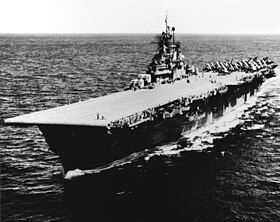USS Bunker Hill (CV-17)
 USS Bunker Hill (CV-17), October 1945 |
|
| Overview | |
|---|---|
| Shipyard | |
| Order | 1940 |
| Keel laying | September 15, 1941 |
| Launch | December 7, 1942 |
| 1. Period of service |
|
| Commissioning | May 24, 1943 |
| Decommissioning | January 9, 1947 |
| Whereabouts | Scrapped in 1973 |
| Technical specifications | |
| Data at the time of commissioning | |
| displacement |
27,100 ts |
| length |
265.8 m |
| width |
45 m |
| Draft |
8.8 m |
| crew |
2,600 men |
| drive |
8 boilers, 4 turbines, 4 screws, 150,000 hp |
| speed |
33 knots |
| Range |
16,900 nm at 15 kn |
| Armament |
|
| Planes |
80-100 |
The USS Bunker Hill (CV-17) was an aircraft carrier of the Essex class of the United States Navy . The carrier was the first ship to be named in memory of the Battle of Bunker Hill on June 17, 1775.
history
construction
The keel laying of Bunker Hill took place on 15 September 1941 the Group for Bethlehem Steel belonging Fore River Shipyard held in Quincy (Massachusetts). After 14 months of construction, on 7 December 1942, the launch ; the commissioning took place on May 24, 1943 under Captain JJ Ballentine.
commitment
In support of operations during the Pacific War , the USS Bunker Hill had its first missions in the attack on Rabaul on November 11, 1943 and in the Gilbert Islands . It was also used when landing on Tarawa on December 13th of that year. Other companies in the Bismarck Archipelago , the Marshall Islands and on Truk were supported by the USS Bunker Hill and its aircraft.

After missions with the Mariana Islands on February 23, 1944 and Palau from April 21 to 28, the battle of the Philippine Sea again took place among the Mariana Islands . There, the USS Bunker Hill was covered on June 19 by a Japanese bomb , which narrowly missed the ship, in a rain shower that killed two crew members and wounded over 80 others. However, the carrier was able to continue to intervene in the battle, and fighter jets of the USS Bunker Hill destroyed part of the 476 lost Japanese machines during the so-called " Mariana Turkey Shooting " during the day .
Following these operations, aircraft from the USS Bunker Hill were able to successfully complete missions in the Caroline Islands , Okinawa , Luzon and Formosa . At the end of 1944, the aircraft carrier was then overhauled in Bremerton , Washington , for just under two months.
In late January 1945, the USS Bunker Hill returned to the ranks of the front ships. Meanwhile, the line of battle had shifted close to the main Japanese islands. The aircraft carrier was used in the Battle of Iwojima . USS Bunker Hill aircraft attacked targets in Honshu , the Nansei Islands and Okinawa with the 5th Fleet . The carrier's machines were also involved in the attack on the Japanese fleet in the China Sea . Four Japanese destroyers, a cruiser and the battleship Yamato were sunk on April 7th .
During the Battle of Okinawa , two Kamikaze pilots managed to hit the USS Bunker Hill off Kyūshū in quick succession . 372 crew members died in this attack. Another 264 were wounded. The aircraft carrier itself was so badly damaged that it had to return to Bremerton immediately.
The USS Bunker Hill was not operational again until September 1945 and brought American units back to the USA until January 1946 during Operation Magic Carpet . She then returned to Bremerton and was assigned to the reserve fleet. A reclassification was made three times for the anchored USS Bunker Hill . The last was downgraded to an aircraft transporter as the AVT-9 in May 1959.
In November 1966, the ship was removed from the register of the US Navy, but not yet scrapped. In the port of San Diego , the carrier served as a test platform for new electronic components. It wasn't until May 1973 that the USS Bunker Hill was sold for scrapping.
Web links
- CV (Engl.)
- Images of Bunker Hill (Engl.)

